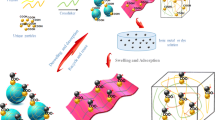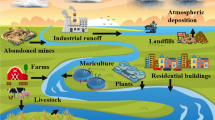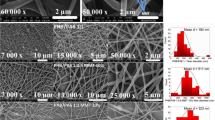Abstract
A regenerable hydrogel composite is described that is comprised of alginate, amino-functionalized metal-organic framework (MIL-101(Cr)-NH2) and magnetite nanoparticles. The composite was characterized by scanning electron microscopy, Fourier-transform infrared spectroscopy, vibrating-sample magnetometry and Brunauer–Emmett–Teller measurement. The material was applied to the magnetic solid-phase extraction of six polar chlorophenoxy acid (CPA) herbicides. Specifically, the herbicides clofibric acid, 4-chlorophenoxyacetic acid, 2,4-dichlorophenoxyacetic acid, 2-(2,4-dichlorophenoxy)propionic acid, 2,4,5-trichlorophenoxyacetic acid and 2-(2,4,5-trichlorophenoxy)propionic acid were extracted from environmental aqueous samples and analyzed by ultra-HPLC-tandem mass spectrometry. The abundance of hydroxyl and carboxyl groups on the natural polymer renders alginate a superior hydrophilic coating. It brings the polar acidic herbicides into closer proximity to the porous metal-organic framework. When integrated with MIL-101(Cr)-NH2, the composite material combines the favorable attributes of high hydrophilicity and large adsorption capacity. An orthogonal array design matrix was employed for the optimization of the extraction parameters. Under the most favorable conditions, the method displays a wide linear response and low limits of detection (0.43–16 ng⋅L−1). Precision and reproducibility (with relative standard deviations of ≤13%) are satisfactory. Enrichment factors range between 27 and 107. The composite was applied to the extraction of CPA herbicides from lake and pond water samples. A markedly improved sorbent-based extraction procedure and performance (compared to previous methods) is found.

Schematic of the magnetic solid-phase extraction of polar herbicides using a hydrogel composite as sorbent. The amino–functionalized MIL–101(Cr) and hydrophilic alginate work in synergy resulting in a material which possess favorable attributes of both components that are beneficial for extraction.




Similar content being viewed by others
References
Li H, Eddaoudi M, O'Keeffe M, Yaghi OM (1999) Design and synthesis of an exceptionally stable and highly porous metal-organic framework. Nature 402:276–279. https://doi.org/10.1038/46248
Liu C, Yu LQ, Zhao YT, Lv YK (2018) Recent advances in metal-organic frameworks for adsorption of common aromatic pollutants. Microchim Acta 185(7):342–353. https://doi.org/10.1007/s00604-018-2879-2
Wang X, Ye N (2017) Recent advances in metal-organic frameworks and covalent organic frameworks for sample preparation and chromatographic analysis. Electrophoresis 38(24):3059–3078. https://doi.org/10.1002/elps.201700248
Li N, Zhang L, Nian L, Cao B, Wang Z, Lei L, Yang X, Sui J, Zhang H, Yu A (2015) Dispersive micro-solid-phase extraction of herbicides in vegetable oil with metal-organic framework MIL-101. J Agric Food Chem 63(8):2154–2161. https://doi.org/10.1021/jf505760y
Gu ZY, Chen YJ, Jiang JQ, Yan XP (2011) Metal-organic frameworks for efficient enrichment of peptides with simultaneous exclusion of proteins from complex biological samples. Chem Commun 47(16):4787–4789. https://doi.org/10.1039/c1cc10579e
Jia Y, Su H, Wang Z, Wong YE, Chen X, Wang M, Chan TD (2016) Metal-organic framework@microporous organic network as adsorbent for solid-phase microextraction. Anal Chem 88(19):9364–9367. https://doi.org/10.1021/acs.analchem.6b03156
Huang CY, Song M, Gu ZY, Wang HF, Yan XP (2011) Probing the adsorption characteristic of metal-organic framework MIL-101 for volatile organic compounds by quartz crystal microbalance. Environ Sci Technol 45(10):4490–4496. https://doi.org/10.1021/es200256q
Zhai Y, Li N, Lei L, Yang X, Zhang H (2014) Dispersive micro-solid-phase extraction of hormones in liquid cosmetics with metal–organic framework. Anal Methods 6(23):9435–9445. https://doi.org/10.1039/c4ay01763c
Tan SC, Lee HK (2019) A metal-organic framework of type MIL-101(Cr) for emulsification-assisted micro-solid-phase extraction prior to UHPLC-MS/MS analysis of polar estrogens. Microchim Acta 186(3):165–173. https://doi.org/10.1007/s00604-019-3289-9
Huang Z, Lee HK (2015) Micro-solid-phase extraction of organochlorine pesticides using porous metal-organic framework MIL-101 as sorbent. J Chromatogr A 1401:9–16. https://doi.org/10.1016/j.chroma.2015.04.052
Wang T, Wang J, Zhang C, Yang Z, Dai X, Cheng M, Hou X (2015) Metal-organic framework MIL-101(Cr) as a sorbent of porous membrane-protected micro-solid-phase extraction for the analysis of six phthalate esters from drinking water: a combination of experimental and computational study. Analyst 140(15):5308–5316. https://doi.org/10.1039/c5an00553a
Huang Z, Lee HK (2015) Performance of metal-organic framework MIL-101 after surfactant modification in the extraction of endocrine disrupting chemicals from environmental water samples. Talanta 143:366–373. https://doi.org/10.1016/j.talanta.2015.05.006
Rieter WJ, Taylor KML, Lin W (2007) Surface modification and functionalization of nanoscale metal-organic frameworks for controlled release and luminescence sensing. J Am Chem Soc 129(32):9852–9853. https://doi.org/10.1021/ja073506r
Zhuo N, Lan Y, Yang W, Yang Z, Li X, Zhou X, Liu Y, Shen J, Zhang X (2017) Adsorption of three selected pharmaceuticals and personal care products (PPCPs) onto MIL-101(Cr)/natural polymer composite beads. Sep Purif Technol 177:272–280. https://doi.org/10.1016/j.seppur.2016.12.041
Liu L, Ge J, Yang L-T, Jiang X, Qiu L-G (2016) Facile preparation of chitosan enwrapping Fe3O4 nanoparticles and MIL-101(Cr) magnetic composites for enhanced methyl orange adsorption. J Porous Mater 23(5):1363–1372. https://doi.org/10.1007/s10934-016-0195-y
World Health Organization (2017) Guidelines for drinking-water quality. Fourth Edition Incorporating the First Addendum, https://www.who.int/water_sanitation_health/publications/drinking-water-quality-guidelines-4-including-1st-addendum/en/. Accessed 6 March 2019
Moral A, Caballo C, Sicilia MD, Rubio S (2012) Highly efficient microextraction of chlorophenoxy acid herbicides in natural waters using a decanoic acid-based nanostructured solvent prior to their quantitation by liquid chromatography-mass spectrometry. Anal Chim Acta 709:59–65. https://doi.org/10.1016/j.aca.2011.10.016
Lin SL, Fuh MR (2010) Orthogonal array optimization of ultrasound-assisted emulsification-microextraction for the determination of chlorinated phenoxyacetic acids in river water. J Chromatogr A 1217(21):3467–3472. https://doi.org/10.1016/j.chroma.2010.03.039
Jung BK, Hasan Z, Jhung SH (2013) Adsorptive removal of 2,4-dichlorophenoxyacetic acid (2,4-D) from water with a metal–organic framework. Chem Eng J 234:99–105. https://doi.org/10.1016/j.cej.2013.08.110
Duo H, Wang Y, Wang L, Lu X, Liang X (2018) Zirconium(IV)-based metal-organic frameworks (UiO-67) as solid-phase extraction adsorbents for extraction of phenoxyacetic acid herbicides from vegetables. J Sep Sci 41(22):4149–4158. https://doi.org/10.1002/jssc.201800784
Lan WG, Wong MK, Chee KK, Sin YM (1995) Orthogonal array design as a chemometric method for the optimization of analytical procedures. Part 3. Five-level design and its application in a polarographic reaction system for selenium determination. Analyst 120(2):273–279. https://doi.org/10.1039/an9952000273
Bagheri H, Karimi Zandian F, Javanmardi H, Abbasi A, Golzari Aqda T (2018) Nanostructured molybdenum oxide in a 3D metal organic framework and in a 2D polyoxometalate network for extraction of chlorinated benzenes prior to their quantification by GC-MS. Microchim Acta 185(12):536–545. https://doi.org/10.1007/s00604-018-3070-5
Fotovat H, Khajeh M, Oveisi AR, Ghaffari-Moghaddam M, Daliran S (2018) A hybrid material composed of an amino-functionalized zirconium-based metal-organic framework and a urea-based porous organic polymer as an efficient sorbent for extraction of uranium(VI). Microchim Acta 185(10):469–476. https://doi.org/10.1007/s00604-018-2991-3
Li N, Wang Z, Zhang L, Nian L, Lei L, Yang X, Zhang H, Yu A (2014) Liquid-phase extraction coupled with metal-organic frameworks-based dispersive solid phase extraction of herbicides in peanuts. Talanta 128:345–353. https://doi.org/10.1016/j.talanta.2014.04.084
Xia L, Liu L, Xu X, Zhu F, Wang X, Zhang K, Yang X, You J (2017) Determination of chlorophenoxy acid herbicides by using a zirconium-based metal–organic framework as special sorbent for dispersive micro-solid-phase extraction and high-performance liquid chromatography. New J Chem 41(6):2241–2248. https://doi.org/10.1039/c6nj03378d
Huang Z, Lee HK (2015) Study and comparison of polydopamine and its derived carbon decorated nanoparticles in the magnetic solid-phase extraction of estrogens. J Chromatogr A 1414:41–50. https://doi.org/10.1016/j.chroma.2015.08.039
Zhou F, Zhou J, Gao X, Kong C, Chen L (2017) Facile synthesis of MOFs with uncoordinated carboxyl groups for selective CO2 capture via postsynthetic covalent modification. RSC Adv 7(7):3713–3719. https://doi.org/10.1039/c6ra25396b
Ferreira RB, Scheetz PM, Formiga ALB (2013) Synthesis of amine-tagged metal–organic frameworks isostructural to MIL-101(Cr). RSC Adv 3(26):10181–10184. https://doi.org/10.1039/c3ra23443f
Lin Y, Kong C, Chen L (2012) Direct synthesis of amine-functionalized MIL-101(Cr) nanoparticles and application for CO2 capture. RSC Adv 2(16):6417–6419. https://doi.org/10.1039/c2ra20641b
Zhu L, Ee KH, Zhao L, Lee HK (2002) Analysis of phenoxy herbicides in bovine milk by means of liquid–liquid–liquid microextraction with a hollow-fiber membrane. J Chromatogr A 963(1–2):335–343. https://doi.org/10.1016/S0021-9673(02)00138-3
Duan YP, Dai CM, Zhang YL, Ling C (2013) Selective trace enrichment of acidic pharmaceuticals in real water and sediment samples based on solid-phase extraction using multi-templates molecularly imprinted polymers. Anal Chim Acta 758:93–100. https://doi.org/10.1016/j.aca.2012.11.010
Rosales-Conrado N, Leon-Gonzalez ME, Perez-Arribas LV, Polo-Diez LM (2008) Multiresidue determination of chlorophenoxy acid herbicides in human urine samples by use of solid-phase extraction and capillary LC-UV detection. Anal Bioanal Chem 390(2):759–768. https://doi.org/10.1007/s00216-007-1701-5
Maldaner L, Jardim IC (2012) Determination of some organic contaminants in water samples by solid-phase extraction and liquid chromatography-tandem mass spectrometry. Talanta 100:38–44. https://doi.org/10.1016/j.talanta.2012.08.006
Sack C, Vonderbrink J, Smoker M, Smith RE (2015) Determination of acid herbicides using modified QuEChERS with fast switching ESI(+)/ESI(−) LC-MS/MS. J Agric Food Chem 63(43):9657–9665. https://doi.org/10.1021/acs.jafc.5b04093
Santos TCR, Rocha JC, Barcelo D (2000) Determination of rice herbicides, their transformation products and clofibric acid using on-line solid-phase extraction followed by liquid chromatography with diode array and atmospheric pressure chemical ionisation mass spectrometric detection. J Chromatogr A 879(1):3–12. https://doi.org/10.1016/S0021-9673(00)00100-X
Acknowledgements
The authors gratefully acknowledge the National University of Singapore (NUS) and NUS Environmental Research Institute for the support provided throughout the duration of this research (Grant No. 143-000-023-001). S.C. Tan is thankful to the NUS Graduate School for Integrative Sciences and Engineering for a scholarship award.
Author information
Authors and Affiliations
Corresponding author
Ethics declarations
The author(s) declare that they have no competing interests.
Additional information
Publisher’s note
Springer Nature remains neutral with regard to jurisdictional claims in published maps and institutional affiliations.
Electronic supplementary material
ESM 1
(DOCX 1.39 mb)
Rights and permissions
About this article
Cite this article
Tan, S.C., Lee, H.K. A hydrogel composite prepared from alginate, an amino-functionalized metal-organic framework of type MIL-101(Cr), and magnetite nanoparticles for magnetic solid-phase extraction and UHPLC-MS/MS analysis of polar chlorophenoxy acid herbicides. Microchim Acta 186, 545 (2019). https://doi.org/10.1007/s00604-019-3679-z
Received:
Accepted:
Published:
DOI: https://doi.org/10.1007/s00604-019-3679-z




